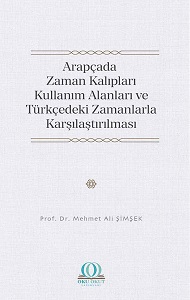Arapçada Zaman Kalıpları: Kullanım Alanları ve Türkçedeki Zamanlarla Karşılaştırılması
The Forms of the Time in Arabic: Their Places in Use and Comparison with the Times in Turkish
Author(s): Mehmet Ali Şimşek
Subject(s): Language and Literature Studies, Morphology, Syntax, Lexis, Comparative Linguistics, Turkic languages
Published by: Oku Okut Yayınları
Keywords: Arabic Language and Rhetoric; Arabic Verbs; Verbals; Tense Expressions; Turkish Tenses;
Summary/Abstract: Time is a phenomenon interlinked with an act because an act must occur at a specific time. There are three foundational times in all languages. These are past, present, and future.
The time of occurrence for a specific action is indicated in Arabic by the verb because it expresses the time of action. Verbs in Arabic get separated into three forms: the perfect, the imperfect, and the imperative, a version derived from the imperfect. The basis of the time system in Arabic is composed of these three forms.
The perfect indicates the past, the imperfect indicates both the present and the future, and the imperative indicates the future time. These times expressed by verbs are morphological times which the verbs provide independent of any context.
Time can also be expressed with forms other than verbs. These forms are the active participle, the passive participle, the verbal noun, and the infinitive. Time expressions of these forms occur when used within sentences. This is called syntactical time. Syntactical time can only be understood by looking at the whole sentence. Because the factor that expresses the tense, here, is the fluency of the sentence and the context of it, rather than the forms used. When associated with syntactical time, the perfect can refer to present tense and future tense. The same goes for the imperfect as well, it may refer to the past tense. The time indicated by the verbs and the other forms -which act as verbs- can be inferred with the knowledge of their either linguistic or situational con-text.
Prepositions especially provide for these tense changes that occur in sentences. For example, the imperfect verb used with ﻢـْ
ﻟَ and
ﺎﻤﱠﻟَ indicates the past tense, and the perfect verb used with the conditional preposition نْإِ refers to the future tense. The imperfect verb; except for ﻢـْ
ﻟَ and
ﺎﻤﱠﻟَ
, when it comes as meczum or as mansup, refers to past tense, and refers to future tense when it gets used as merfu.
Therefore, to understand the tense of a sentence in Arabic one must recognize the prepositions in it. Apart from prepositions, which provide linguistic con-text, the expression of time can also be determined by the situation at the moment of utterance. The situational context, which we call hâlî karine, plays a major role in determining the tense expressed by verbs and nouns which get used instead of verbs.
In the first part of our study, The Forms of the Time in Arabic, Their Places in Use and Comparison with the Times in Turkish, occurrences of the morphological and the syntactical times are observed along with their usage areas.
In the second part, Arabic counterparts of Turkish Forms of time are given and compared. By doing so, it is aimed to make learning and teaching the forms of time, in Turkish and Arabic Languages, easier.
- E-ISBN-13: 978-605-74416-1-4
- Page Count: 299
- Publication Year: 2021
- Language: Turkish
- eBook-PDF
- Table of Content
- Introduction

